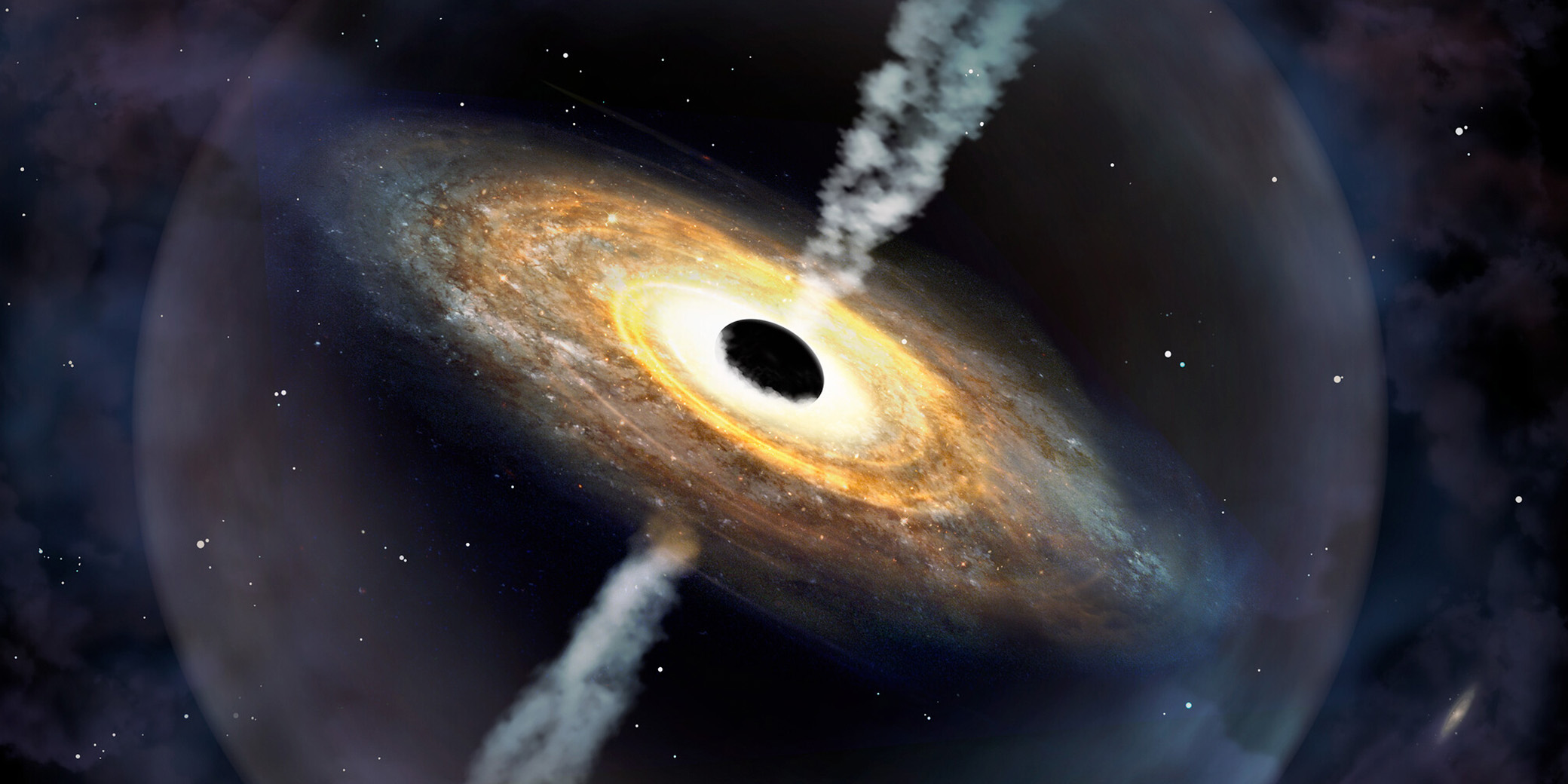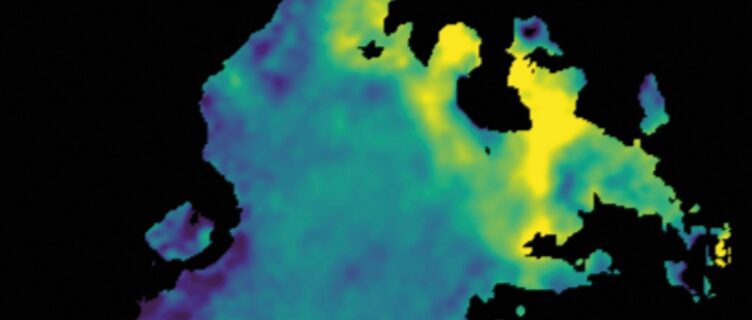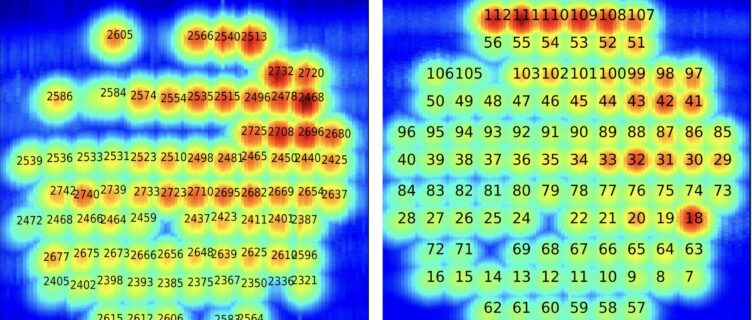Astronomers have detected cold molecular gas in the form of carbon monoxide in the host galaxy of a supermassive black hole at an early epoch in cosmic history, corresponding to when the Universe was only seven hundred million years old. The discovery was made by an international team led by researchers from the Italian National Institute for Astrophysics (INAF) using the NOEMA observatory in the French Alps. The results are published in Astrophysical Journal Letters.
How do the growth of a supermassive black hole and its host galaxy influence each other? What impact do such black holes have on the earliest phases of galaxy evolution? An international team of scientists has investigated these questions, which are among the thorniest in modern astrophysics. To find out more, they looked at one of the three brightest, most distant quasars known, whose light started its cosmic journey around thirteen billion years ago, when the Universe was only seven hundred million years old.
Quasars are the extremely bright cores of active galaxies, owing their enormous luminosity to the intense activity of the supermassive black hole swallowing matter at the galaxy’s centre. The chosen quasar, known as Pōniuā‘ena – which in Hawaiian language “evokes the unseen spinning source of creation, surrounded by brilliance” – is powered by a black hole with the mass of one and a half billion Suns. The host galaxy traces its origins to the middle of the Reionisation Epoch, which occurred a few hundred million years after the Big Bang. During the Reionisation Epoch, the Universe became transparent to the radiation produced by stars and galaxies, so that their light can reach us today. Quasars like Pōniuā‘ena emerged rather early in the cosmic timeline, as they are found in extreme environments characterised by the accumulation of vast amounts of gas and dust, but the reasons for such a quick appearance still remains one of the biggest mysteries in modern extragalactic astrophysics.
By observing the Pōniuā‘ena quasar with the Northern Extended Millimeter Array (NOEMA), the most powerful radio telescope of its kind in the northern hemisphere, the team detected cold molecular gas in the form of carbon monoxide in the interstellar medium of the host galaxy. It is a record-breaking detection: never before had cold molecular gas been seen so early in the history of the Universe.
Cold molecular gas is thought to be one of the key ingredients for the efficient formation of stars. As a result, astronomers anticipate the existence of molecular gas early in the history of the universe, even before stars formed in large quantities. Consequently, the discovery of carbon monoxide in Pōniuā’ena represents a new milestone toward understanding the formation of the very first molecules in the Universe. “It’s the first time that we measure the reservoir of cold molecular gas and dust in the early Universe, at a redshift of 7.5, only a few hundred million years after the Big Bang”, explains Chiara Feruglio, INAF researcher in Trieste and first author of the study. “We find that galaxies hosting quasars in the ancient Universe already have the capacity to build up substantial amounts of molecular gas and dust: around twenty billion solar masses, comparable to what is observed at later cosmic epochs. It is also interesting to note that, despite the short cosmic time elapsed between the Big Bang and the epoch in which we observe the Pōniuā‘ena quasar, the relative amounts of cold gas and dust is already quite similar to what we see in our galaxy, the Milky Way, and other galaxies in the present Universe”.

Map of the molecular gas (carbon monoxide) emission from the Poniua‘ena quasar, obtained with NOEMA. In the lower part of the image, the emission line detection. Credits: IRAM/NOEMA/C. Feruglio (INAF)
“We know that this quasar hosts a very massive black hole that must have formed either from a massive primordial concentration of mass or via gas accretion at very high rates onto smaller mass concentrations” adds Francesca Civano, Chief Scientist at NASA Goddard Space Flight Center and co-author of the research. “The observations were planned to study only the dust component. We did not expect to detect a large reservoir of cold gas as well, in part because no cold gas has yet been detected in the two other quasars known at such distances. Surprisingly, we found two very strong emission lines, indicating a massive reservoir of cold and dense gas”.
IRAM astronomer and co-author Jan Martin Winters adds: “Only the remarkable sensitivity recently attained by NOEMA, coupled with its large frequency bandwidth, enabled the discovery of carbon monoxide in Pōniuā‘ena. The newly gained power of NOEMA now holds the promise to detect cold molecular gas in many more quasar hosts at these early cosmic times. Such detections would allow us to also shed light on the production of heavy elements in the earliest phases of the Universe”.
Molecular hydrogen is of fundamental importance as it is the basic constituent from which stars are born, and so it is often called the star formation reservoir. Unfortunately, the molecular hydrogen cannot be observed itself, but an empirical relation between the mass of carbon monoxide gas and the mass of molecular hydrogen gas can be used to derive the amount of molecular hydrogen from the measured amount of carbon monoxide. The observation of carbon monoxide in Pōniuā’ena therefore enabled the team to obtain a first estimate of the cosmic density of molecular hydrogen. Such estimates were so far limited to much later epochs in cosmic history, starting from around one billion years after the Big Bang. “The cosmic density of molecular hydrogen estimated from observations of the Pōniuā‘ena quasar”, concludes INAF researcher and co-author Umberto Maio, ”is in agreement with predictions from the most recent models of cold gas formation and evolution in the earliest phases of the Universe, as well as from cosmological simulations”. This result indicates that theoretical models are on the right path to explaining fundamental properties of the early Universe.
Co-author Luca Zappacosta from INAF, leader of the HYPERION Science Collaboration, notes: “Pōniuā‘ena belongs to HYPERION, a sample of early bright quasars which have been specifically selected because of the extreme feeding habits of their massive black holes. By studying HYPERION quasars we aim at understanding the nature of such an early emergence of these puzzling sources and characterizing the concurrent evolution of a black hole and its host galaxy. In this context, this record-breaking detection is crucial as it sets the stage to uncover the role of cold molecular gas build up in the first forming quasars and the greedy black hole feeding habits”.
For more information
The paper “HYPERION: First constraints on dense molecular gas at z=7.5149 from the quasar Pōniuā‘ena”, by Chiara Feruglio, Umberto Maio, Roberta Tripodi, Jan Martin Winters, Luca Zappacosta, Manuela Bischetti, Francesca Civano, Stefano Carniani, Valentina D’Odorico, Fabrizio Fiore, Simona Gallerani, Michele Ginolfi, Roberto Maiolino, Enrico Piconcelli, Rosa Valiante, Maria Vittoria Zanchettin, is published online in Astrophysical Journal Letters.
This presentation/publication has received funding from the European Union’s Horizon 2020 research and innovation programme under grant agreement No 101004719 (ORP).
INSU/CNRS news announcement (in French)
Science contacts
Chiara Feruglio, INAF, Osservatorio Astronomico di Trieste
Jan Martin Winters, Institut de Radioastronomie Millimétrique (IRAM)
Press contacts
INAF Press Office – Marco Galliani, +39 335 1778428
IRAM Press Office – Karin Zacher, +33 476 82 21 03
![]()

Our latest updates
Explore all the latest news from our research and technology groups and never miss out on important upcoming events.














